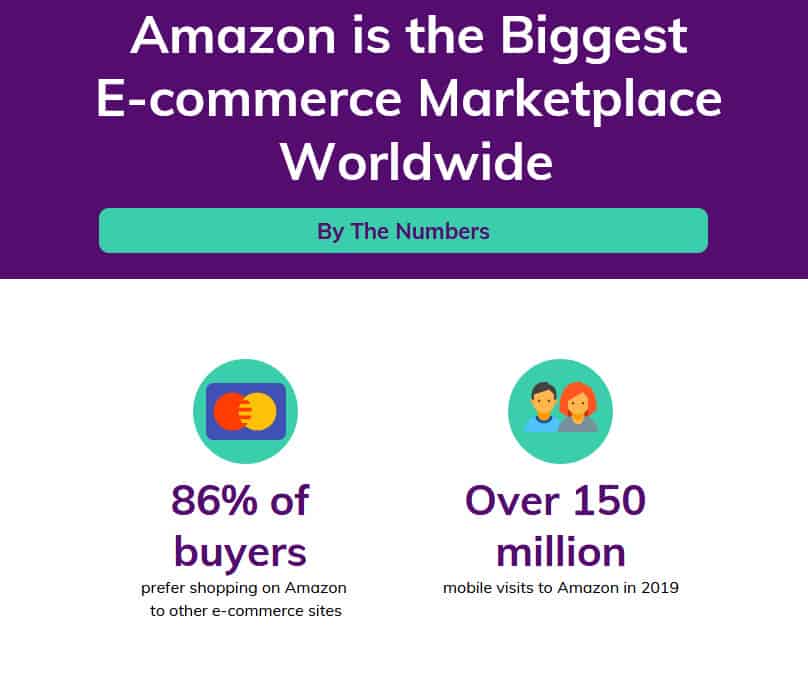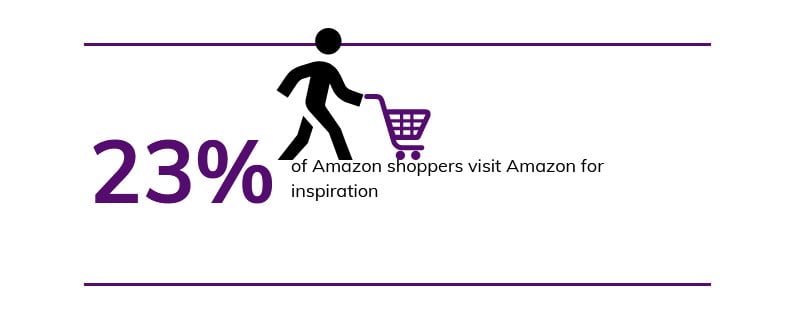Many people erroneously believe duplicate listings do not affect brands especially because it achieves the aim of making more sales and more profit, but that is not the case.
Duplicate listings can have adverse effects on brands if sellers do not get rid of them quickly.
Below are a few ways duplicate listings affect brands:
Infiltration of the Market with Counterfeit Products
Amazon is the biggest e-commerce marketplace worldwide, in 2019 over 150.6 million mobile users visited Amazon and 86% of buyers prefer shopping on Amazon to other e-commerce sites.
 Infographic Wireframe
Infographic Wireframe
Amazon sees such high figures because most online shoppers believe in the quality of products sold on the platform. However, duplicate listings can make the figures drop due to terrible customer experience.
When sellers deliberately duplicate the listing of a product, there is every tendency that the products they have to sell are counterfeit especially since they do not have the same UPC as the original product.
Most online shoppers do not have the knowledge on how to identify a counterfeit product when shopping online, and for websites like Amazon, most of them let their guards down because it is a reputable site.
So if they click on a duplicate listing with a counterfeit product and make a purchase, they will assume that the counterfeit is from the brand. This will lead to a loss of credibility for the company.
And if the counterfeit is harmful to human health or contains outdated or misleading information, the brand could get sued, which can ruin the reputation of your business both online and offline.
Reduction of Sales Volume
Data reveals that 23% of Amazon shoppers visit Amazon for inspiration.
 Infographic Wireframe
Infographic Wireframe
This means they do not have a particular brand in mind before coming online so they compare lots of products and brands before settling on the one to buy and some of them make their choices based on the quality of content on the product page.
If you have a duplicate product listing, you may lose these customers and also reduce your sales because if they click on a duplicate listing and then click on your original listing, the information on the two listings won’t be the same.
While the original listing has a well-researched content, the duplicate listing may have a poorly researched content filled with outdated information. And they will view the discrepancy of the information they see on the two listings as an attempt to market fake products with false or conflicting information.
This will make them dump your brand and go in search of a brand without duplicate product listings.
Unverified Sellers Marketing your Product
The credibility of a seller is as important as the quality of the product being sold.
Having duplicate listings on Amazon means that there are unverified sellers out there selling your brand. With over 2.5 million active sellers on Amazon, it will be hard to verify the identity of the sellers creating these duplicates.
 Infographic Wireframe
Infographic Wireframe
That they can duplicate your listing means that they have very little morals and cannot be trusted to represent your brand.
You may not think this is a big deal, but it is because how they act can ruin the image of your brand. Most of them are just out to make money; they do not care about protecting the image of your business. If your brand gets ruined, they will move to the next one.
Diverted Sales
If you have the buy-box of the original listing of a product in Amazon, duplicate listings can make you lose out in profits from sales. The duplicators may sell the products but they’ll divert the earnings and ratings you should have gotten into their account.
This is bad because no business can thrive for long if it is making sales that do not benefit it.
Diverted Reviews
Reviews are a surefire way to improve the rank of your product on the Amazon search results page. The higher the reviews, especially positive reviews, the higher the chances of your product appearing in the top search listing. And this translates to an increase in conversions and sales.
But it will be hard for your product to gain more visibility and rank high if there is a duplicate listing. A sizable percentage of your target audience will view the duplicate listing and some will make a purchase from it, which means you have fewer customers buying from you.
Customers will write the reviews they should have left on your product page after making a purchase from you on the product page of the duplicate listing. And if the product they purchased from the duplicate is substandard, they will leave a negative review which will affect your business and your ASIN if you merge the duplicate listing with the original listing in the future.
Poor Customer Experience
Duplicate listings ruin the experience of customers when searching for products in Amazon, this doesn’t just affect the brand, it also affects the UX on Amazon.
Duplicate listings make the same product to appear multiple times in the search result page, which makes it difficult for customers to differentiate the listings. If customers keep experiencing this whenever they shop on Amazon, they’ll lose confidence in both the brand and the platform.





